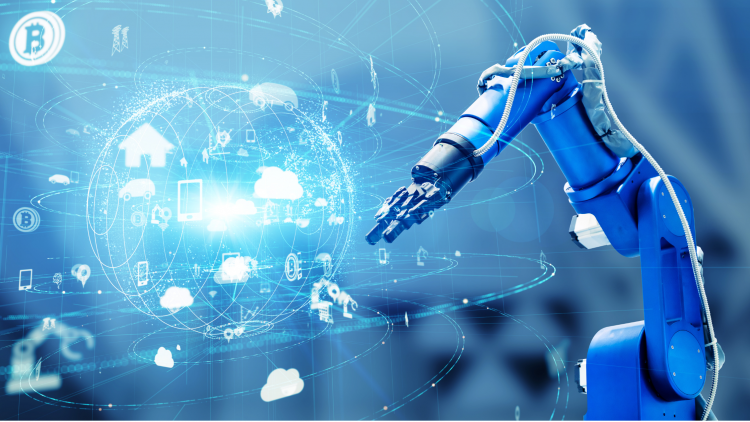The rapid advancement of technology is reshaping industries across the globe, and one of the most transformative changes is the rise of robotic automation powered by artificial intelligence (AI).
As businesses look for ways to stay competitive, reduce costs, and improve efficiency, AI-driven automation in manufacturing and logistics is increasingly becoming a game-changer.
The integration of robots and AI is enhancing productivity, improving precision, and enabling 24/7 operations—all of which are propelling industries towards a new era of innovation.
This article explores how robotic automation is revolutionizing global manufacturing and logistics, its benefits, and challenges, and how AI-powered robots are shaping the future of industries worldwide.
1. The Evolution of Robotic Automation
Robotic automation in manufacturing and logistics is not a new concept. For decades, traditional robots have been employed to carry out repetitive tasks such as assembling parts, packaging products, and performing quality checks. However, these robots were often limited in their capabilities, requiring humans to oversee operations and address any complexities.
The shift towards AI-powered robotic automation represents a new frontier. AI-enabled robots can learn, adapt, and optimize their operations based on data insights, becoming more autonomous and capable of handling complex tasks. This has been made possible by advancements in machine learning, computer vision, and robotic process automation (RPA), which allow robots to recognize patterns, make decisions, and operate with minimal human intervention.
– AI-Powered Manufacturing: Precision, Efficiency, and Customization
AI-driven automation in manufacturing is transforming production lines, enhancing both product quality and operational efficiency. Some of the key benefits of AI-powered robots in manufacturing include:
-Enhanced Precision and Quality Control
Robots powered by AI can perform highly precise tasks with **micrometer-level accuracy, reducing human error and ensuring that every product meets quality standards. In industries such as automotive manufacturing, where precision is critical, robots are increasingly used for assembly tasks such as welding, painting, and component placement. AI-enabled systems can also analyze products in real time to detect defects and initiate corrective measures, ensuring that only high-quality products are produced.
-Example: In automotive assembly, robots are now capable of conducting real-time inspections using computer vision systems, identifying even the smallest defects in a car’s paintwork or body. The AI algorithms analyze data from cameras and sensors, allowing robots to make immediate corrections to prevent further defects.
2. Increased Efficiency and Speed
AI-powered robots can operate 24/7 without the need for breaks, increasing production rates and throughput while reducing downtime. Unlike human workers, robots can perform tasks continuously without fatigue, and with their ability to optimize production processes, they can increase overall efficiency on the factory floor.
– Example: Companies like Tesla and BMW have integrated AI-driven robots to streamline assembly lines, improving throughput and ensuring faster delivery times for vehicles. The use of AI in predictive maintenance also helps avoid costly machine failures by monitoring equipment health and scheduling timely repairs before a breakdown occurs.
3. Flexibility and Customization
In the past, robotic automation was best suited for mass production, where standardization was key. However, AI is enabling robots to handle more flexible and customized production. With machine learning algorithms, robots can adapt their actions based on real-time data and respond to changes in product specifications or customer demands.
– Example: In the electronics industry, AI robots can assemble various types of products, such as smartphones and smartwatches, without the need for reprogramming or manual intervention. This capability is helping manufacturers pivot quickly to meet changing consumer preferences.
-AI-Powered Logistics: Revolutionizing the Supply Chain
AI-driven automation is equally transformative in the logistics and supply chain sectors, where efficiency, speed, and accuracy are paramount. Robotics is helping businesses meet rising consumer demands while overcoming challenges such as labor shortages, rising costs, and supply chain disruptions. Some of the ways AI-powered robotics is transforming logistics include:
-Autonomous Vehicles and Drones
In logistics, autonomous vehicles and drones are rapidly changing the way goods are transported. AI enables these vehicles to navigate efficiently, avoid obstacles, and make decisions in real time without human intervention. From warehouses to delivery networks, AI-driven vehicles are enhancing the speed and efficiency of the supply chain.
– Example: Amazon’s Prime Air uses drones to deliver packages in select areas, reducing delivery times and cutting operational costs. Similarly, self-driving trucks are being tested by companies like Uber Freight and Waymo, offering the potential for long-haul deliveries without human drivers.
-Warehouse Automation
AI-powered robots are increasingly being used to automate tasks in warehouses, from sorting and picking to packing and inventory management. These robots are designed to navigate complex warehouse environments, identify products, and perform actions with speed and precision. The use of AI and machine learning allows these robots to continually optimize their operations based on real-time data and changing conditions within the warehouse.
Example: Ocado, a leading UK-based grocery retailer, has implemented a robotic warehouse system that uses AI to automate the process of picking groceries for customers. The system can handle thousands of products and orders simultaneously, drastically reducing order fulfillment times and costs.
– Predictive Analytics for Supply Chain Optimization
AI is also revolutionizing logistics through predictive analytics, which helps companies optimize their supply chains. By analyzing large volumes of data, AI systems can predict demand patterns, forecast supply chain disruptions, and optimize inventory management. These insights enable businesses to make more informed decisions, minimize delays, and reduce costs.
– Example: DHL, one of the world’s largest logistics companies, uses AI-based systems to predict shipping routes, forecast demand fluctuations, and optimize inventory across its global network of warehouses. By leveraging machine learning, DHL can reduce delivery times and increase operational efficiency.
4. The Future of AI-Powered Automation
As AI continues to advance, the potential for robotic automation in manufacturing and logistics is limitless. Several trends are shaping the future of AI-powered robotics in these sectors:
-Collaboration Between Humans and Robots
The future of automation is not about replacing humans but about human-robot collaboration. Cobots, or collaborative robots, are designed to work alongside human workers, assisting with repetitive tasks and allowing humans to focus on more complex, creative problem-solving activities. This will enable companies to leverage the strengths of both humans and robots for maximum efficiency.
– Expansion into New Industries
While manufacturing and logistics are leading the way in AI-powered robotics, these technologies are beginning to be adopted in other industries as well, such as healthcare, construction, and agriculture. AI robots are increasingly being used for tasks such as surgical assistance, field harvesting, and construction site surveying, broadening the scope of automation across sectors.
-Ethical and Regulatory Considerations
As robotic automation becomes more pervasive, there will be a growing need to address ethical and regulatory concerns, particularly regarding job displacement, data privacy, and safety. Governments, industries, and workers’ unions will need to collaborate to develop regulations that ensure fair labor practices and secure AI systems.
The global shift towards AI-powered manufacturing and logistics is not just a technological evolution; it’s a revolution that is transforming industries, enhancing productivity, and enabling new business models. From precision manufacturing to autonomous delivery systems, AI-driven robotics are reshaping the way goods are produced, stored, and distributed.
While challenges remain, particularly in terms of workforce adaptation and regulatory frameworks, the future of robotic automation looks bright.
As companies continue to invest in AI and robotics, businesses will be able to drive efficiency, increase agility, and stay ahead in an increasingly competitive global economy.
The widespread adoption of robotic automation is set to define the next era of innovation, with the potential to significantly improve productivity, reduce operational costs, and enhance customer experiences.
Read more on Tech Gist Africa:
Cybersecurity Challenges and Solutions in African Businesses
Artificial Intelligence and Machine Learning in African Industries
Digital Transformation in Government: E-Governance Initiatives in Africa











Comments 1